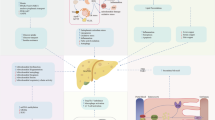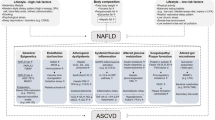Abstract
To analyse the relationship of PAI-1 plasma levels to echographically determined liver steatosis and cardiometabolic risk factors in a randomly selected sample of 254 adult male participants of the Olivetti Heart Study. Accounting for age and ongoing pharmacological treatment, PAI-1 levels were directly (P < 0.005) associated with body mass index (BMI), waist circumference (WC), serum triglyceride (TG), total cholesterol, insulin, homeostasis model assessment index, gamma-glutamyl transpeptidase and peritoneal fat. At multiple linear regression (MLR) analysis, measures of adiposity and TG exerted significant and quantitatively similar effects on PAI-1 levels. A progressive rise in PAI-1 level was detected with increasing degree of steatosis. A stepwise MLR model was used to evaluate the relative power of cardiometabolic risk factors and liver steatosis on PAI-1 levels. Adjusting for alcohol intake, BMI, WC and peritoneal fat were alternatively included in the model with other variables found to be significantly associated with plasma PAI-1 level. Liver steatosis, serum TG and various indexes of adiposity each had a significant independent impact on PAI-1 plasma level and explained overall 23% of its variability. Abdominal fat, liver steatosis and serum TG levels were significant and independent determinants of PAI-1 plasma level in an unselected sample of adult male population upon adjustment for age and therapy.

Similar content being viewed by others
References
Loskutoff DJ, Samad F (1998) The adipocyte and hemostatic balance in obesity: studies of PAI-1. Arterioscler Thromb Vasc Biol 18:1–6
Dellas C, Loskutoff DJ (2005) Historical analysis of PAI-1 from its discovery to its potential role in cell motility and disease. Thromb Haemost 93:631–640
Kruithof EKO (1988) Plasminogen activator inhibitor type 1: biochemical, biological and clinical aspects. Fibrinolysis 2:59–70
Samad F, Loskutoff DJ (1996) Tissue distribution and regulation of plasminogen activator inhibitor-1 in obese mice. Mol Med 2:568–582
Mertens I, Van Gaal LF (2005) Visceral fat as a determinant of fibrinolysis and hemostasis. Semin Vasc Med 5:48–55
Schafer K, Fujisawa K, Konstantinides S, Loskutoff DJ (2001) Disruption of the plasminogen activator inhibitor 1 gene reduces the adiposity and improves the metabolic profile of genetically obese and diabetic ob/ob mice. FASEB J 15:1840–1842
Vaughan DE (2005) PAI-1 and atherothrombosis. J Thromb Haemost 3:1879–1883
Margaglione M, Di Minno G, Grandone E et al (1994) Abnormally high circulation levels of tissue plasminogen activator and plasminogen activator inhibitor-1 in patients with a history of ischemic stroke. Arterioscler Thromb 14:1741–1745
Thögersen AM, Jansson JH, Boman K et al (1998) High plasminogen activator inhibitor and tissue plasminogen activator levels in plasma precede a first acute myocardial infarction in both men and women. Evidence for the fibrinolytic system as an independent primary risk factor. Circulation 98:2241–2247
Hamsten A, de Faire U, Walldius G et al (1987) Plasminogen activator inhibitor in plasma: risk factor for recurrent myocardial infarction. Lancet 2:3–9
Juhan-Vague I, Pyke SD, Alessi MC et al (1996) Fibrinolytic factors and the risk of myocardial infarction or sudden death in patients with angina pectoris: ECAT Study Group: European Concerted Action on Thrombosis and Disabilities. Circulation 94:2057–2063
Juhan-Vague I, Alessi MC, Mavri A, Morange PE (2003) Plasminogen activator inhibitor-1, inflammation, obesity, insulin resistance and vascular risk. J Thromb Haemost 1:1575–1579
Appel SJ, Harrell JS, Davenport ML (2005) Central obesity, the metabolic syndrome, and plasminogen activator inhibitor-1 in young adults. J Am Acad Nurse Pract 17:535–541
Juhan-Vague I, Alessi MC, Vague P (1991) Increased plasma plasminogen activator inhibitor-1 levels. A possible link between insulin resistance and atherothrombosis. Diabetologia 34:457–462
Mertens I, Verrijken A, Michiels JJ et al (2006) Among inflammation and coagulation markers, PAI-1 is a true component of the metabolic syndrome. Int J Obes (Lond) 30:1308–1314
Cigolini M, Targher G, Agostino G et al (1996) Liver steatosis and its relation to plasma haemostatic factors in apparently healthy men—role of the metabolic syndrome. Thromb Haemost 76:69–73
Bruckert E, Ankri A, Giral P, Turpin G (1994) Relation between plasminogen activator inhibitor-1 and hepatic enzyme concentrations in hyperlipidemic patients. Thromb Haemost 72:434–437
Akahoshi M, Amasaki Y, Soda M et al (2001) Correlation between fatty liver and coronary risk factors: a population study of elderly men and women in Nagasaki, Japan. Hypertens Res 24:337–343
Osono Y, Nakajima K, Hata Y (1995) Hypertriglyceridemia and fatty liver: clinical diagnosis of fatty liver and lipoprotein profiles in hypertriglyceridemic patients with fatty liver. J Atheroscler Thromb 2:S47–S52
Strazzullo P, Barba G, Cappuccio FP et al (2001) Altered renal sodium handling in men with abdominal adiposity. A link to hypertension. J Hypertens 19:2157–2164
Matthews DR, Hosker JP, Rudenski AS et al (1985) Homeostasis model assessment: insulin resistance and beta-cell function from fasting plasma glucose and insulin concentrations in man. Diabetologia 28:412–419
Bonora E, Kiechl S, Willeit J et al (1998) Prevalence of insulin resistance in metabolic disorders: the Bruneck Study. Diabetes 47:1643–1649
Ribeiro-Filho FF, Faria AN, Azjen S et al (2003) Methods of estimation of visceral fat: advantages of ultrasonography. Obes Res 11:1488–1494
Strauss S, Gavish E, Gottlieb P, Katsnelson L (2007) Interobserver and intraobserver variability in the sonographic assessment of fatty liver. AJR Am J Roentgenol 189:W320–W323
Adams LA, Angulo P (2005) Recent concepts in non-alcoholic fatty liver disease. Diabet Med 22:1129–1133
Joseph AE, Saverymuttu SH, al-Sam S et al (1991) Comparison of liver histology with ultrasonography in assessing diffuse parenchymal liver disease. Clin Radiol 43:26–31
Palmentieri B, de Sio I, La Mura V et al (2006) The role of bright liver echo pattern on ultrasound B-mode examination in the diagnosis of liver steatosis. Dig Liver Dis 38:485–489
Grundy SM, Cleeman JI, Daniels SR et al (2005) Diagnosis and management of the metabolic syndrome: an American Heart Association/National Heart, Lung, and Blood Institute Scientific Statement. Circulation 112:2735–2752
Alessi MC, Bastelica D, Mavri A et al (2003) Plasma PAI-1 levels are more strongly related to liver steatosis than to adipose tissue accumulation. Arterioscler Thromb Vasc Biol 23:1262–1268
Targher G, Bertolini L, Scala L et al (2005) Non-alcoholic hepatic steatosis and its relation to increased plasma biomarkers of inflammation and endothelial dysfunction in non-diabetic men. Role of visceral adipose tissue. Diabet Med 22:1354–1358
Fan JG, Chen LH, Xu ZJ, Zeng MD (2001) Overexpression of hepatic plasminogen activator inhibitor type 1 mRNA in rabbits with fatty liver. World J Gastroenterol 7:710–712
de Larrañaga G, Wingeyer SP, Graffigna M et al (2008) Plasma plasminogen activator inhibitor-1 levels and nonalcoholic fatty liver in individuals with features of metabolic syndrome. Clin Appl Thromb Hemost 14:319–324
Nilsson L, Gafvels M, Musakka L et al (1999) VLDL activation of plasminogen activator inhibitor-1 (PAI-1) expression: involvement of the VLDL receptor. J Lipid Res 40:913–919
Olufadi R, Byrne CD (2006) Effects of VLDL and remnant particles on platelets. Pathophysiol Haemost Thromb 35:281–291
McCuskey RS, Ito Y, Robertson GR et al (2004) Hepatic microvascular dysfunction during evolution of dietary steatohepatitis in mice. Hepatology 40:386–393
Li Z, Yang S, Lin H et al (2003) Probiotics and antibodies to TNF inhibit inflammatory activity and improve nonalcoholic fatty liver disease. Hepatology 37:343–350
Yin M, Wheeler MD, Kono H et al (1999) Essential role of tumor necrosis factor alpha in alcohol-induced liver injury in mice. Gastroenterology 117:942–952
Villanova N, Moscatiello S, Ramilli S et al (2005) Endothelial dysfunction and cardiovascular risk profile in nonalcoholic fatty liver disease. Hepatology 42:473–480
Jepsen P, Vilstrup H, Mellemkjaer L et al (2003) Prognosis of patients with a diagnosis of fatty liver—a registry-based cohort study. Hepatogastroenterology 50:2101–2104
Volzke H, Robinson DM, Kleine V et al (2005) Hepatic steatosis is associated with an increased risk of carotid atherosclerosis. World J Gastroenterol 11:1848–1853
Sieri S, Agudo A, Kesse E et al (2002) Patterns of alcohol consumption in 10 European countries participating in the European Prospective Investigation into Cancer and Nutrition (EPIC) project. Public Health Nutr 5(6B):1287–1296
Volpato S, Pahor M, Ferrucci L et al (2004) Relationship of alcohol intake with inflammatory markers and plasminogen activator inhibitor-1 in well-functioning older adults: the Health, Aging, and Body Composition study. Circulation 109:607–612
Mukamal KJ, Jadhav PP, D’Agostino RB et al (2001) Alcohol consumption and hemostatic factors: analysis of the Framingham Offspring cohort. Circulation 104:1367–1373
Sasaki A, Kurisu A, Ohno M, Ikeda Y (2001) Overweight/obesity, smoking, and heavy alcohol consumption are important determinants of plasma PAI-1 levels in healthy men. Am J Med Sci 322:19–23
Djousse L, Pankow JS, Arnett DK et al (2000) Alcohol consumption and plasminogen activator inhibitor type 1: the National Heart, Lung, and Blood Institute Family Heart Study. Am Heart J 139:704–709
Ishii M, Yoshioka Y, Ishida W et al (2005) Liver fat content measured by magnetic resonance spectroscopy at 3.0 tesla independently correlates with plasminogen activator inhibitor-1 and body mass index in type 2 diabetic subjects. Tohoku J Exp Med 206:23–30
Alessi MC, Lijnen HR, Bastelica D, Juhan-Vague I (2003) Adipose tissue and atherothrombosis. Pathophysiol Haemost Thromb 33:290–297
Conflict of interest statement
The authors declare that they have no conflict of interest related to the publication of this manuscript.
Author information
Authors and Affiliations
Consortia
Corresponding author
Additional information
The Olivetti Heart Study Research Group: P. Strazzullo (coordinator), G. Barba, F. P. Cappuccio, E. Farinaro, F. Galletti, A. Siani.
Rights and permissions
About this article
Cite this article
Barbato, A., Iacone, R., Tarantino, G. et al. Relationships of PAI-1 levels to central obesity and liver steatosis in a sample of adult male population in southern Italy. Intern Emerg Med 4, 315–323 (2009). https://doi.org/10.1007/s11739-009-0240-9
Received:
Accepted:
Published:
Issue Date:
DOI: https://doi.org/10.1007/s11739-009-0240-9




